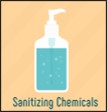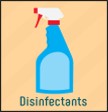Solutions
Did You Know?
The Difference Between Cleaning vs. Sanitizing vs. Disinfecting As Defined By Our Partners At Planned Companies
Cleaning: removes germs, dirt and impurities from surfaces or objects. Cleaning works by using soap (or detergent) and water to physically remove germs from surfaces. This process does not necessarily kill germs, but by removing them it lowers their numbers and the risk of spreading infection.

Sanitizing: lowers the number of germs on surfaces or objects to a safe level, as judged by public health standards or requirements. This process works by either cleaning or disinfecting surfaces or objects to lower the risk of spreading infection.

Disinfecting: kills germs on surfaces or objects. Disinfecting works by using chemicals to kill germs on surfaces or objects, including bacteria, viruses or other contaminants. This process does not necessarily clean dirty surfaces or remove germs, but by killing germs on a surface after cleaning, it can further reduce the risk of spreading infection.
Note: In order to disinfect you must (1) Clean, and then (2) Disinfect.

Electrostatic Disinfecting
Electrostatic cleaning is the process of spraying an electrostatically charged mist onto surfaces and objects. Electrostatic spray uses a disinfectant solution that is combined with air and atomized by an electrode inside the sprayer.
This positively charges particles so that they aggressively adhere to surfaces and objects, clinging to and fully coating any surface that they are aimed at, including hard to reach places, thus applying chemicals in a more efficient, controlled manner and maximizing coverage of disinfectants. This makes electrostatic spraying an effective method of neutralizing contaminants including bacteria, viruses and other blood-borne pathogens, such as influenza and COVID-19.
Note: For this service, the client is responsible to make sure all areas are dust and residue free to ensure effectiveness of electrostatic spraying.
Cleaning & Electrostatic Disinfecting
We will provide the necessary labor and cleaning materials to properly prep for the electrostatic spraying.
Our professionals will first clean your space with a spray and wipe cleaning methodology, ensuring that all dust, dirt, grime and debris are removed from the areas to be disinfected. After cleaning has been completed, our team will commence electrostatic disinfecting to tackle all desired areas including hard to reach spots such as crevices, corners or awkwardly shaped objects.
The nature of the mist allows it to coat surfaces evenly and envelope objects, even if the mist is only sprayed from one side, effectively eradicating contaminants.
Cleaning & Disinfecting
Our professionals will first clean your space with a spray and wipe cleaning methodology, ensuring that all dust, dirt, grime and debris are removed from surfaces within reach.
Once the space has been pre-cleaned by our team, they will disinfect areas using a CDC approved disinfectant. Our professionals are properly trained on specific dwell or “kill times”, which are the required time guidelines that a disinfectant must remain wet on a surface in order to effectively neutralize all contaminants.
Once the specified time has passed, we will wipe down the surfaces in order to ensure the entire area is disinfected prior to disposal of materials and PPE.
Cleaning, Disinfecting and Electrostatic Disinfecting
We recommend a combination of cleaning, disinfecting and electrostatic spaying in order to maximize coverage and have the highest effectiveness in killing bacteria and viruses. We will first clean your space with a spray and wipe cleaning methodology, ensuring that all dust, dirt, grime and debris are removed from surfaces within reach.
Once the space has been pre-cleaned by our team, they will disinfect using a CDC approved disinfectant. Once the disinfectant has had ample time to dwell and kill the contaminants, our cleaners will wipe down the areas before beginning the process of electrostatic spraying to tackle all the hard-to-reach areas such as crevices, corners or awkwardly shaped objects. The nature of the mist allows it to coat surfaces evenly and envelope objects – even if the mist is only sprayed from one side.
After servicing our associates will dispose of any contaminated materials and PPE before closing off the space to prevent further entry while the chemicals seep into all crevices and surfaces to disinfect.



